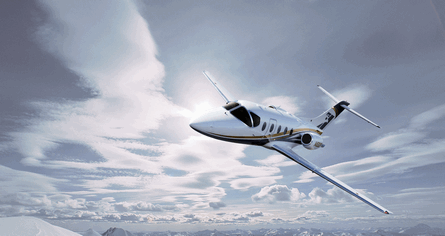Hawker Beechcraft is investing in performance boosts for the Hawker 450XP and a FlexCabin concept for the King Air 350i, which makes its debut as a mock-up here at NBAA.
“The 450XP was really driven by our customers who wanted to see the aircraft upgraded in regard to avionics,” explains president of commercial sales Brad Hatt. The Rockwell Collins Pro Line 4 gave way to the Pro line 21, but at the aircraft’s back-end each Pratt & Whitney JT15D-5R was swapped with a PW535D.
“The big difference in the engine is new technology which gives you better specific fuel consumption, which is about an 8% improvement,” says Hatt. “That, coupled with the engine being flat-rated to plus 20°C, gives it a much better performance.”
Most importantly in range, he says, which benefits when the engine can run 12°C hotter. “That allows you to operate the engine on a higher temperature from take-off in hot environments, as well as in time to climb, so you can get up to altitude quicker,” he says.
 |
|---|
© Hawker Beechcraft |
Elevation and location are important, too, Hatt says, pointing out the range improvement of 140 miles flying out of Teterboro and 500 miles flying out of Denver. The new engines give more thrust per pound of fuel. Useful load is up, but the maximum payload is down. The new price is $7.695 million.
Inside the cabin, up to nine new seats blend with newly-sculpted walls and ledging, which are now home to a Rockwell Collins Venue CMS infotainment system, which lets individual passengers control their entertainment and environment. LED lights surround the seats.
A survey carried out by the Wolf Agency was launched in 2002 and has showed increased speed and interior upgrades were on customers’ minds, along with range and, most importantly, new avionics. With that in hand, the past years have seen a flurry of upgrades.
“We’ve upgraded the engines on both the C90 and the King Air 200 and we’ve upgraded all three King Airs with Collins Pro Line 21,” says Hatt. “With the King Air 350i we’re redesigning the back end of the airplane.”
The first 350i will be delivered in the Fall of 2009, one year after its mock-up debut during this convention. “Normally, one wouldn’t think that an interior upgrade is a major announcement - until you’ve actually seen it and the mock-up,” he adds.
 |
|---|
© Hawker Beechcraft |
The mock-up fuselage is split into three sections, allowing entrance into just the cockpit or the storage area and lavatory, with the cabin in between.
This twin-turboprop costs $6.526m, but Hatt says the atmosphere there is one of a jet costing millions more, showing style and quality coupled with versatility. “It’s a very modular design with regards to the cabinetry,” he explains. A variety of arrangements are possible for the seating, too. “You can take all four of the aft club seating out,” he says. This new “FlexCabin” concept lets the cabin be reconfigured between flights, with ottomans replacing those seats or leaving empty space for storage or stretching out.
“That basically allows you to have a lounge back there. Two of them, actually. You’re able to recline and have a foot rest and look at a large 15-inch display using Bluetooth technology that just gives a phenomenal clarity,” Hatt says. Infotainment is available to each of the eight cabin seats, with access to the Airshow service and interconnectivity for devices such as iPods. Shutters are obsolete here, with electric shades dimming the windows at the touch of a button.
An eleventh person can ride buckled in to the closed seat of what Hatt calls “a fully legal belted potty. In that back galley, for the first time ever in a King Air you have a full unitization lav back there, with running water and mirrors and vanity, as well as a storage area.”
Comfort design extends to noise control. “A lot of it is just in passive designs that we’ve learned over the years - how to package soundproofing material as well as the type of material you use as well as the overall design layout,” says Hatt. “It’s not in any one way we do it, but the overall accomplishment is a 4dB improvement, which is really significant.”
That was but one challenge for the extremely busy design teams at Hawker Beechcraft’s Wichita headquarters, which have been undertaking “a very aggressive new product upgrade to our entire new proud family line”, Hatt says. “Last year we did the Hawker 750, the Hawker 900XP, the King Air B200GT and the C90GTI. And then, of course, this year we started deliveries of the Hawker 4000, and at EBACE in May we announced the Premier II to the marketplace, which will be available in the second quarter of 2010 as well”.
Sales continue to soar, with record overseas orders offsetting the slowing demand from a sluggish US economy. To complete those orders, Hawker Beechcraft announced last Wednesday an expansion to its completions centre in Little Rock, Arkansas.
“It went from about 60 aircraft a year to where we’re going to be doing close to 150 aircraft a year,” says Hatt. “We’ve had to add brand new hangar capacity, paint facility and back shops where we build our interiors.”
 |
|---|
© Hawker Beechcraft |
Source: Flight International























